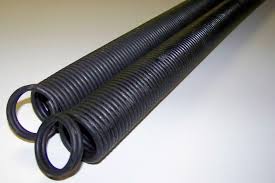
Let us just say that there are springs for any garage door and it’s essential to find the ideal spring system for your door for maximum performance and fewer problems. So let’s run a quick check of the main spring differences:
- There are springs for sectional, rollup, and one-piece garage doors.
- Extension springs come always in pairs whereas the torsion spring is one – regardless if you choose to install more than one.
- All springs are coiled, but some coils are more flexible than others.
- The hardware of the Clopay torsion springs – also known as E-Z set spring – is a bit different from standard torsion spring systems and they are easier to install.
- Wayne Dalton torsion springs are found inside the shaft and this makes them safer.
- Rolling door torsion springs are nested inside the barrel.
Extension vs. Torsion Springs
- Torsion springs stretch to unwind in order to open the door but not as much extension springs do when they keep the door shut. So torsion systems don’t lose flexibility fast.
- Torsion types are designed to last for a longer time (15 to 20 thousand cycles) than extension systems (up to 10 thousand cycles).
- Since there is one extension spring in each side of the door if one is damaged, loose, or broken, there will be an operational problem and you will have to replace both springs. Torsion springs keep better control.
- With the shaft going around or through the torsion spring, this type is actually safer. With extension types, you need to install safety cables to be sure they won’t fly and hurt you.
- Extension springs have more parts and longer garage door cables and need more maintenance.
- Since torsion springs offer better door balance, there is less strain to the garage door opener.
Galvanized vs. Oil Tempered Torsion Springs

Another advantage of oil tempered springs is that they are much stronger to begin with. That’s due to the way they are manufactured. They are heated in very high temperatures, cooled, and reheated. And this process makes them really resistant. Is garage door spring repair still vital? It definitely is. In order to remain flexible and thus functional, all springs need lubrication. And that’s their similarity.







